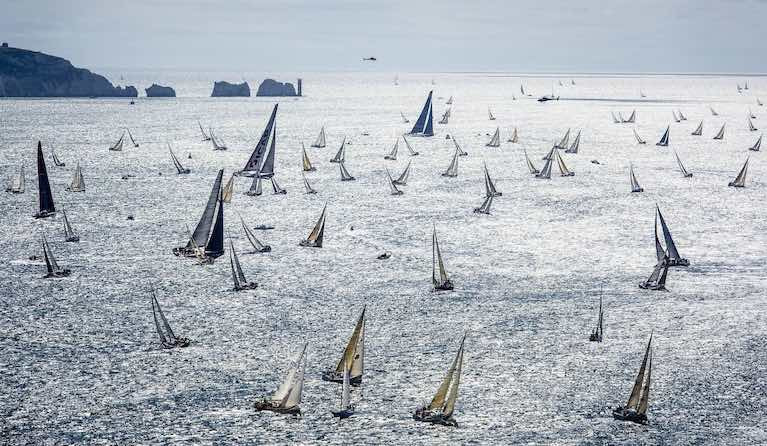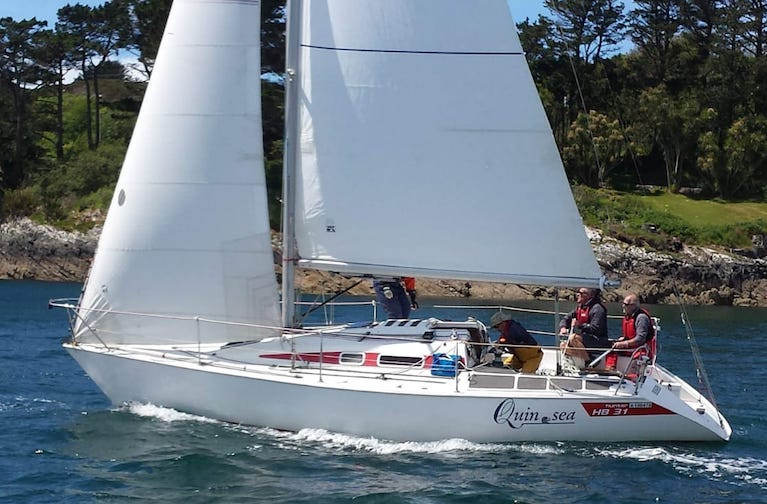Displaying items by tag: Fastnet
Back in the dark latter days of the Pandemic, high-flying rumours began circulating about a new Botin 52 being completed in New Zealand. Normally, the multi-titled 52 class sees only incremental improvements as the latest boats take up this ultimate challenge on the modern scene. But the word was that this boat had more bright ideas than a waggonload of Einsteins - she would knock most other 52s out of the ballpark. And when this new boat Caro campaigned her first major at Hamilton Island, this did indeed prove to be the case, to such an extent that formerly dedicated TP owners reckoned it would be a step too far to try to keep up with this latest level of the arms race.
Caro is as international as she is successful. Designed in Santander in Northern Spain, she was engineered by Pure and built in New Zealand by Core Builders Composites under the supervision of Mark Turner (no stranger to Irish sailors), with the overall project management in the hands of Justin Ferris from Doyle Sails NZ.
Owner Max Klink has her down as registered in Switzerland, yet her sail numbers in 2023 seem to emanate from the Cayman Islands. Whatever, this supra-national mix has provided a boat of such exceptional speed and achievement that merely to be listed on her potential crew panel is high recognition. And to be on board – as Cian Guilfoyle of the National YC was - for a global peak like the 50th Fastnet Race is talent-recognition of a high honour .
So although they lost their supposedly-essential electronic masthead wand while getting an added pasting in the edge of Portland Race while outward bound, Adrian Stead and his crew always found that bit of almost super-natural extra speed for which Caro is increasingly renowned, despite having to use some very ancient helming skills to find it. And thus, Cian Guilfoyle, the Irish member of this remarkable team, is our Offshore Sailor of the Month for July.
 Cleaned up in every sense – Caro’s overall winners looking fresh and well in Cherbourg
Cleaned up in every sense – Caro’s overall winners looking fresh and well in Cherbourg
Cork’s Honorary Special Veteran Maluka’s Handy Little Hitch-Hike To Europe For The 50th Fastnet Race
Sean Langman’s superbly-restored 1932-vintage 30ft Sydney Harbour Ranger Class gaff cutter Maluka finally put the Fastnet Rock astern at 9:00 hrs this morning (Wednesday), and now her crew - including the legendary Gordon Maguire - are making the best of things and then some, despite the unpleasant weather, by having her marching down the road to the Bishop Rock at a busy 7 knots and better.
It all seems a world way away from the beautiful early-summer conditions of late May, when the big lift-ship bringing the two recently-acquired Patrol Vessels acquired from the New Zealand Navy for Ireland’s Naval Service came into Cork Harbour. For after the two biggies had been craned into their new home waters, it emerged that the lift-ship had acquired a stowaway, as there on deck was the tiny Maluka, probably asking “Are we nearly there yet?”
 Rigged and ready to go – Maluka feeling at home in Crosshaven in late May’s perfect weather. She sails under the colours of the Port Huron Sailing Club in Tasmania in honour of the gold-standard Huon pine from which she is constructed. Photo: Neil Kenefick
Rigged and ready to go – Maluka feeling at home in Crosshaven in late May’s perfect weather. She sails under the colours of the Port Huron Sailing Club in Tasmania in honour of the gold-standard Huon pine from which she is constructed. Photo: Neil Kenefick
STOWAWAY TO IRELAND?
It turned out that just as Sean Langan had fallen on his feet by hearing about the convenient one-way passage to Europe for his beloved boat, so Maluka hit the sweet spot by making Crosshaven her temporary home. When Sean and Gordon spent a week there as Maluka arrived, so many rallied round to help prepare her that they’d time for other commitments, and Neil Kenefick was able to organise a waterborne outing or two with high-speed powerboats, across to Cobh to put the world to rights with Edddie English at the old Royal Cork HQ, or round to Kinsale for a feast of fruits de mer - as one does.
 Gordon Maguire and Eddie English in serious discussion (we can guess the topic) at the old Royal Cork YC building in Cobh. Photo: Neil Kenefick
Gordon Maguire and Eddie English in serious discussion (we can guess the topic) at the old Royal Cork YC building in Cobh. Photo: Neil Kenefick
REMEMBERING TONY FARRELLY AND CRYSTAL CLEAR
But it turns out that, in classic Fastnet style, there are those who dispute that Maluki is the smallest boat ever to have done the Fastnet Race. For instance, there were quite a few Ron Holland-designed and volumetrically much smaller 30ft Shamrock Half Tonners which completed the course in times past, a regular being Tony Farrelly from County Cavan who received a round of applause when his Crystal Clear came into Plymouth’s Millbay Dock after completing the exceptionally rough 1985 race.
However, way before that there was a County Down doctor called Davy Park who had graduated from building and racing successful Enterprises into building his own mini-offshore racers, starting with a van de Stadt-designed Yachting World “Builder-her-Yourself” Chieftain, which was either 18ft LOA or maybe 23ft – either way, she was as small a boat as either of us wished to compete in the Ailsa Craig Race, even if we did get there in the end.
 Whipping up an appetite – seaborne at speed on the way to Kinsale are Neil Kenefick, Gordon Maguire, Sean Langman and Crosshaven 1720 sailor Padraig Byrne
Whipping up an appetite – seaborne at speed on the way to Kinsale are Neil Kenefick, Gordon Maguire, Sean Langman and Crosshaven 1720 sailor Padraig Byrne
 The hard life of a sailor bold…Neil Kenefick, Gordon Maguire and Sean Langman in Kinsale after the local reputation for superb seafood seems to have stood up to scrutiny
The hard life of a sailor bold…Neil Kenefick, Gordon Maguire and Sean Langman in Kinsale after the local reputation for superb seafood seems to have stood up to scrutiny
DAVY PARK CHANCES HIS ARM
He then went on to complete a Mike Henderson-designed Spinner Class 27-footer from a fibreglass hull, and as she had the RORC’s minimum waterline length of 24ft, he decided to chance his arm with a Fastnet Race entry, and got away with it. But as he and his navigator Kevin MacLaverty came round the breakwater at Plymouth to finish, they were asked to keep out of the way as the alickadoos at the lighthouse needed the space to finish the racers.
Thus all hell broke loose when they found out that this tiny pale blue boat had herself just raced round the Rock, despite being very obviously not 30ft long. Yet they allowed Davy’s quite good overall placing to stand, although the 30ft rule has been fairly strictly imposed ever since. But fortunately it allows the wonderful Maluka in – if only just – to provide entertainment for those of us who’ll root for the oddballs every time around.
 She may be the most unusual boat in the 50th Fastnet Race, but the highly individual Maluka is no slouch in a breeze
She may be the most unusual boat in the 50th Fastnet Race, but the highly individual Maluka is no slouch in a breeze
50th Fastnet Race Date Announced by RORC - Saturday, 22nd July 2023
Following the success of the 2021 Rolex Fastnet Race from Cowes to Cherbourg-en-Cotentin, the Royal Ocean Racing Club (RORC) and its French partners are delighted to announce the date for the next edition of its flagship event in 2023. The 50th edition of the world’s largest offshore race will start from the Royal Yacht Squadron line on Saturday 22nd July, 2023, prior to the annual Cowes Week festivities.
Jean-Louis Valentin, President of the Arrival Fastnet Cherbourg Association comments: “We are delighted to once again welcome the arrival of the mythical Rolex Fastnet Race in Cherbourg-en-Cotentin in 2023. The Association and Public Partners; the City of Cherbourg-en-Cotentin, the Agglomeration Community du Cotentin, the Department of Manche and the Normandy Region continue to work hand-in-hand to welcome this great international maritime race to our region. The new date of 22nd July 2023 will attract more people and we will again offer a warm welcome to sailors before the start of the race and a big party at the finish. Our teams are already working with the RORC to make the arrival of this 50th edition a great festival and friendly event for everyone.”
“We will all be looking forward to taking part in what will be a very special anniversary year for the Rolex Fastnet Race. Following the resounding success of this year’s edition, we will again be finishing in Cherbourg and expect to attract a record entry. We feel certain that our partners in France (City of Cherbourg-en-Cotentin, the Agglomeration Community du Cotentin, the Department of Manche and the Normandy Region) will ensure competitors and visitors receive the same warm welcome and will be able to celebrate the golden jubilee race in inimitable French style,” comments RORC Commodore, James Neville.
 Tom Kneen and crew on his JPK 11.80 Sunrise - jubilant after winning the Fastnet Challenge Cup in the 2021 Rolex Fastnet Race Photo: Paul Wyeth
Tom Kneen and crew on his JPK 11.80 Sunrise - jubilant after winning the Fastnet Challenge Cup in the 2021 Rolex Fastnet Race Photo: Paul Wyeth
“The 50th edition of the Rolex Fastnet Race will run before Cowes Week in 2023 in order to cope with the berthing needs of the large fleet prior to the start on 22nd July, and pre-event registration will again be offered to competitors in Cherbourg. We are excited to be working with our hosts once more for the finish of this great race and expect it to be even better than the 2021 event,” says Race Director, Chris Stone.
 The mighty Maxi Skorpios established a monohull record for the new course of 2 days 8 hrs 33 mins and 55 secs
The mighty Maxi Skorpios established a monohull record for the new course of 2 days 8 hrs 33 mins and 55 secs
The biennial 690 nautical mile race is a rite of passage for all those taking part and is one of the very few global events where Corinthian sailors can compete on the same race course as their sporting heroes. The ultimate goal is to take home the overall trophy; the historic Fastnet Challenge Cup - first presented back in 1925, but for most sailors, to complete the race and the tough personal challenge; to test their mettle against others in their class, or to compete against hundreds of passionate sailors from around the globe, is the main attraction of this renowned classic offshore race.
The arrival of the immense fleet will once again be eagerly anticipated, with spectators enjoying the atmosphere of the international yachting festival as boats complete the 690 nautical mile course from Cowes to Cherbourg-en-Cotentin, via the Fastnet Rock. Starting with the first arrivals from the 23rd of July, the daily influx of international competitors on a diverse range of boats culminates in a memorable prizegiving to mark the 50th Rolex Fastnet Race in Cherbourg on Friday 28th July 2023.
Irish Fastnet Race Contender Nieulargo from Royal Cork is Ahead of the Game for Souped-up Performance
Day 3 1900: The early stages of the Fastnet Race 2021 on Sunday went from rugged to very rugged, and not surprisingly there were many retirals before the day was out. But aboard Nieulargo from Crosshaven, ace sailor Nicholas "Nin" O'Leary has since found the time today to give an insight today of what it had been like to slug down channel in severe wind-over-tide conditions in a boat which is a heavy cruiser-racer by comparison with the latest designs: "It was a tough exit out of the Solent past the Needles Fairway, wet'n'wild and we lost wind instruments for 24 hours, but thankfully the four dinghy sailors and small keelboat drivers on board have a natural feel while sailing blind. We had a nice battle with Shirley Robertson and Henry Bomby on the Sun Fast 3300 Swell which kept us on our toes, and Annamarie is keeping the troops fed'n'watered with her famous vegetable soup. We expect it to be lighter across to the Fastnet Rock. ETA 03:00 in the small hours of Wednesday morning".
In much of the current spell of weather whether afloat or ashore, who could resist the thought of a nourishing helping of classic vegetable soup? So much so, in fact, that there's arguably a market opportunity for Mrs Murphy's Special Vegetable Soup for Sailors, if Annamarie Fegan could only be persuaded to use her married name just the once……
Meanwhile in IRC 3 generally, the leading places have been permutated from time to time as they make their way from the north side of the Isles of Scilly toward The Rock, with the wind now just aft of the beam, as forecast. The formidable Alexis Loison in the JPK 10.30 Leon has regained the lead despite being two-handed (he also leads the two-handed division), but although approaching 1900 hrs Nieulargo is shown as being 7th in the class of 73 boats, she's very much in contention.
In a different world towards the finish at Cherbourg, the majestic 140ft Skorpios should be finished just before dark to take mono-hull line honours, and it may well be that the much-discussed final tide gate off Cap de la Hague will have turned in her favour by the time she gets there, so we'll need to wait a little for a full analysis from subsequent finishers of the adverse gate effect.
On down the line, the Imoca 60 Apivia (Charlie Dalin) is holding on to her very clear class lead, but George David's Rambler 88 is doing everything possible to make her third on the water, though it's now only an off chance as they're both getting up towards Start Point with Apivia 18 miles clear ahead
But in any case in Cherbourg, the talk of the town is the emergence of Poland as a force in front-line offshore racing. In this morning's bulletin we outlined how the former Volvo 70 I Love Poland has been at the centre of a comprehensive Polish offshore training programme based around a winter berth at Cascais in Portugal.
But this afternoon the Polish breakthrough has become even clearer – I Love Poland has been in the overall lead for some time, but second overall is now being filled by another Polish-ensigned veteran Volvo 70, in this case Sailing Poland which – with both boats south of Western Cornwall and a dozen miles between them - is sailing slightly faster at the time of writing.
 The Lombard 46 Pata Negra when she brought RORC Caribbean 600 success for Howth YC. This evening at 18:10 she rounded the Fastnet Rock lying first in IRC Class 1 with Andrew Hall of ISORA and Pwllheli SC in command.
The Lombard 46 Pata Negra when she brought RORC Caribbean 600 success for Howth YC. This evening at 18:10 she rounded the Fastnet Rock lying first in IRC Class 1 with Andrew Hall of ISORA and Pwllheli SC in command.
All this is of almost academic interest to the majority of the fleet, who still have to round the Fastnet Rock. But that historic turning point has become increasingly busy as today progressed, and at 1810 this evening there was a rounding of very special significance, as Andrew Hall of ISORA and Pwllheli SC's recently-acquired Lombard 46 Pata Negra put the Fastnet astern and herself into first place in IRC 1 after a wellnigh perfect race from the Isles of Scilly.
Just ahead of Pata Negra on the water is the 1961-vintage 74ft ketch Stormvogel, beautifully restored and in such flying form that she lies 6th on corrected time in IRC 1. The result of a design co-operation for Dutch timber magnate Cess Bruynzeel by Laurent Giles, John Illingworth and Ricus van de Stadt, in many ways Stormvogel still looks as modern as tomorrow, with a rudder separate from her keel in a way that didn't become generally accepted until the mid-60s, yet Bruynzeel had been racing boats like that offshore for years.
 Stormvogel's hull profile was ahead of its time when she first appeared in 1961.
Stormvogel's hull profile was ahead of its time when she first appeared in 1961.
In IRC 4, Irish Offshore Sailing's veteran Sunfast 37 Desert Star has slipped from fourth to 13th after electing to go eastward of the large TSS immediately off Land's End. That said, her crew won't have known that the losing move was about to be exacerbated by a local calm right off the Longships Rocks on the very point of Land's End itself.
Meanwhile, with the wind settled in slightly abaft the beam for the long haul to the Fastnet, it looks as though Kenneth Rumball and Pamela Lee's Fiagro 3 RL Sailing is finding enough power for the foils to start being useful, as they're showing better than ten knots and have confirmed their position as leaders of the admittedly much-reduced Figaro 3 Class.
Tracker below
Fastnet Race Ultimes Round West Cork's Fastnet Rock as Bulk of the Fleet Tackle Start Point
Despite a blustery start and first night at sea in the 49th Rolex Fastnet Race, competitors have been making good progress west down the English Channel, with the bulk of the fleet at breakfast time this morning south of Start Point.
Since yesterday’s dramatic, brutal departure from the Solent for the 337 entries in 25+ knot southwesterly headwinds and violent wind against tide seas, overnight the wind has slowly eased. It is still gusting to the early 20s, especially around headlands, but is dropping the further west the competitors sail, with 15-20 knots off the Lizard and 13-15 off Land’s End.
While the majority of the Fastnet Race fleet is still toughing it out in the Channel, at 0800 BST this morning Maxi Edmond de Rothschild was the first Ultime to reach the Fastnet Rock. While not a record time – in 2019 she led around the Rock at 0633, less than two minutes ahead of Francois Gabart’s MACIF – her time of just 20 hours 50 minutes is almost three hours slower, but nonetheless highly impressive given that this time the boats have been upwind down the Channel and then fetching across the Celtic Sea. This time is also not as close with Thomas Coville’s second placed Sodebo Ultim Voile some 43 miles astern of her.
“We have just passed the Fastnet, leading the fleet,” reported Charlies Caudrelier, co-skipper of Maxi Edmond de Rothschild with Franck Cammas. “We're at least 40 miles ahead of the second which is good. We have sailed very well since the start of this race and are proud of what we have done. The boat is going fast and we have not made any navigation errors. Now we go back to the Scilly Isles. The last part, with gybes, will be complicated. We know that it is difficult to get to Cherbourg, especially when there is little wind. We remain focused on the speed of the boat and we will try to extend our lead. We will not be flying much on this leg to Cherbourg."
 Sam Davies' IMOCA Initiatives Coeurs blasts her way out of the Solent © Rick Tomlinson
Sam Davies' IMOCA Initiatives Coeurs blasts her way out of the Solent © Rick Tomlinson
Most surprising have been the tactics of the Ultimes and some of the IMOCAs, which forged off south after leaving the Solent yesterday and going south of the Casquets Traffic Separation Scheme (TSS). While the Ultimes tacked close to Alderney, some of the IMOCA dived even further south. Initiatives Coeurs skipper Sam Davies explained their reasons for this: “Nico [Lunven, her co-skipper] had done a lot of work on the weather routing with lots of different models and pretty much all of our routing went that way, because we might get flat water in the Alderney Race, sheltered by the Channel Islands and be first into the west going current off the north French coast.”
Hearing her on board, as Initiatives Coeur was passing Land’s End this morning, was difficult as her co-skipper at the time was easing the mainsheet: “We exploded one mainsheet block - it is not an issue, it just makes it bit noisy to trim. Still it is a pleasure to be going at full speed after sailing such a long way around the world in safety mode [completing her lap of the planet after retiring from the Vendee Globe last winter].” This morning Davies was enjoying racing her two close friends Simon Fisher and former Team SCA crew Justine Mettraux, who were alongside her aboard 11th Hour Racing.
Leading the charge among the monohulls is of course Russian Dmitry Rybolovlev’s mighty ClubSwan 125 Skorpios. At 0700 this morning, the largest single-hulled vessel ever to enter the Rolex Fastnet Race was passing between Land’s End TSS and the Scilly Isles, having allowed American George David’s Rambler 88 to split up the east side of the TSS. Perhaps most surprising was that only three miles astern of her at the time was the lead IMOCA, Apivia, a boat less than half Skorpios’ length and being sailed by two talented Frenchmen – Charlie Dalin and Paul Meilhat – their advantage being that their boat has giant foils enabling it literally ‘to fly’.
 Looking good overall under IRC - I Love Poland, the VO70 skippered by Grzegorz Baranowski © I Love Poland
Looking good overall under IRC - I Love Poland, the VO70 skippered by Grzegorz Baranowski © I Love Poland
The big boats were looking good overall under IRC corrected time this morning, especially I Love Poland, the VO70 skippered by Grzegorz Baranowski, which this morning was following the route up the east side of the Land’s End TSS astern of Rambler 88, which lies second overall under IRC. Since the start, IRC Zero has seen three retirements: RORC Vice Commodore Eric de Turckheim on the NMYD 54 Teasing Machine, the Gerd-Jan Poortman-skippered Ker 46 Van Uden and Lance Shepherd's VO70 Telefonica Black.
In IRC One, RORC Commodore James Neville's HH42 Ino XXX was vying for the lead on the water with Elliot 44 CR Matador of Swede Jonas Grander, both offshore en route to the Lizard. However, under IRC, Robert Bottomley's MAT12 Sailplane holds a slender advantage over Andrew Hall’s Lombard 46 Pata Negra. Others such as Richard Loftus’ Swan 65 Desperado (11th under IRC this morning) had shaved Start Point closer and were just tacking out from Plymouth.
Sadly there have been ten retirements from this class, including three favourites; Lann Ael 2, Didier Gaudoux's 2017 overall race winner; L'Ange De Milon, Jacques Pelletier's defending champion in this class and Philippe Frantz NMD 43 Albator. Also out is Cracklin Rosie of former RORC Commodore Steven Anderson.
The IRC Two leaders were this morning due south of Plymouth. The front of the fleet remains at three-way battle between international trio of JPK 10.80 sisterships, Englishman Tom Kneen's Sunrise and Richard Fromentin's Leclerc Hennebont/Cocody from France with Astrid de Vin's Il Corvo from the Netherlands further to their south. These three are also looking good under IRC along with perennial race winner Ross Applebey’s Lightwave 48 Scarlet Oyster
 In IRC One, RORC Commodore James Neville's HH42 INO XXX was vying for the lead on the water Photo: Paul Wyeth/pwpictures.com
In IRC One, RORC Commodore James Neville's HH42 INO XXX was vying for the lead on the water Photo: Paul Wyeth/pwpictures.com
As expected in IRC Three, Alexis Loison and Guillaume Pirouelle aboard the defending class and IRC Two-Handed champion Léon have been leading under corrected time and, impressively, are right up with the front runners in IRC Two. On the water, Léon has Philippe Girardin's J/120 Hey Jude and the JPK 10.80 Raging Bee2 of Cherbourg hero Louis Marie Dussere nearby. However sneaking ahead of Léon and into the IRC Three lead this morning, coming in from the north in the otherwise French dominated class, is the Philip Caswell-skippered Sun Fast 3600 Fujitsu British Soldier. Léon is still well ahead on the IRC Two-Handed class leaderboard. Behind them, the majority in IRC Three have been taking a course tight in to Start Point.
In the void left by perennial IRC Four winner Noel Racine, France still dominates the leaderboard in this class with Francois Charles' Dehler 33 Cruising Sun Hill 3 ahead of Alain Guelennoc's X-332 Trading-advices.com and Ludovic Menahes and David le Goff's JPK 10.10 Raphael. However all were taking different tactics with Trading-advices.com hugging the Devonshire coast en route towards Plymouth with her rivals having tacked offshore. The top British boat is Chris Choules’ modern classic Sigma 38 With Alacrity the top British boat in sixth under IRC. The majority of IRC Four has yet to pass Start Point.
Kenny Rumball and Pamela Lee, the mixed double-handed offshore team from Dun Laoghaire and Greystones, will be on today's Rolex Fastnet Race 2021 start line as the only Irish team competing double-handed and in the Beneteau Figaro 3 Class.
One of 11 boats with Irish interest in the race, the duo are sponsored by Hanley Energy and start with IRC 1 at 1155 BST from the famous start line set from the Flag Staff at the Royal Yacht Squadron in Cowes.
"This year looks set to be an extremely tough race, with the first few days predicted to be beating into strong wind and currents to get around Lands End before heading across the Irish Sea to the Fastnet Lighthouse. No doubt this first half of the race will put all the the crews of the 600 strong fleet to the test and certainly the double-handed, Rumball told Afloat.
This is Rumball’s fourth time competing in the 700-mile race and Lee’s second.
It was a one, two overall for the J109 design in this weekend's Kinsale Yacht Club SCORA Fastnet Race.
Royal Cork yacht Jelly Baby claimed a victory in a corrected time of 21 hours:13 minutes: 26 seconds from the host club's Artful Dodger (Finbarr O'Regan) on 21:24:34 corrected in a race that was shortened due to light winds.
The defending champion Nieulargo, a Grand Soleil 40, finished third on a corrected time of 21:36:02
 Artful DodJer (IRL1713) from Kinsale Yacht Club skippered by Finbarr O'Regan Photo: Bob Bateman
Artful DodJer (IRL1713) from Kinsale Yacht Club skippered by Finbarr O'Regan Photo: Bob Bateman
As Afloat reported yesterday, after a well-timed postponement the nine-boat Kinsale Yacht Club SCORA Fastnet Race got away in a great breeze at 10 am on Saturday morning for its annual offshore race.
 Royal Cork's Nieulargo (IRL2129) skippered by Denis Murphy Photo: Bob Bateman
Royal Cork's Nieulargo (IRL2129) skippered by Denis Murphy Photo: Bob Bateman
The fleet, sponsored by UK Sailmakers Ireland, rounded the much closer Kowloon Bridge south cardinal buoy instead of the Fastnet rock.
Full results are here
Bob Bateman's Kinsale/SCORA Fastnet Race Photo Gallery
Navigating the New 2021 Fastnet Race Course – More Reaching & a New Roll of the Dice
Moving to Cherbourg for the finish of the Royal Ocean Racing Club's premier event, the Rolex Fastnet Race next year will see navigators and crews facing a few significant new challenges writes James Boyd
Firstly the new course is 90 miles (or 15%) longer, making it 695 miles, based on the shortest route. Of this the first 500 miles (or 72%) of the course remains unchanged - setting off from the Royal Yacht Squadron line on Sunday 8 August 2021; heading southwest down the English south coast, negotiating Anvil Point, Portland Bill, Start Point and the Lizard en route, before the vital decision over which side to pass the Traffic Separation Scheme exclusion zone off Land's End. Then there are the open ocean crossings to the Fastnet Rock and back to Bishop Rock, southwest of the Scilly Isles.
 The long final leg to Cherbourg adds 90 miles to the course and is more open, but concluded with the crossing of the Alderney Race. Credit: Expedition Navigation Software & thanks to Ian Moore
The long final leg to Cherbourg adds 90 miles to the course and is more open, but concluded with the crossing of the Alderney Race. Credit: Expedition Navigation Software & thanks to Ian Moore
From here the course changes marginally. From Bishop Rock, it is possible to lay directly Cape de la Hague, the northwesternmost headland of the Cotentin Peninsula, before making the final slight starboard turn for the last 10 miles to the finish line within Cherbourg's harbour. The new course from Bishop Rock is 91°M, compared to 83° to the Lizard, however, the added distance to Cherbourg may affect the make-up of the race overall.
 While the race requires an all-round boat, the new course remains predominantly windward-leeward, albeit more downwind. Credit: Ian Moore
While the race requires an all-round boat, the new course remains predominantly windward-leeward, albeit more downwind. Credit: Ian Moore
More significant will be the final roll of the dice: how best to tackle one of Europe most powerful tidal gates - the Alderney Race, between Alderney and Cape de la Hague. "This is now the biggest tidal gate of the race," states Moore. "It is strongest off Cape de la Hague, through the Swinge (between Alderney and Burhou, northwest of Alderney) and off the eastern Alderney shore. The tidal effect also covers a much larger area than it does off Portland Bill. There will be winners and losers here and it will be hard to get right."
The Alderney Race’s effect will also be increased after start day’s new moon, with finishers into Cherbourg expecting during a period with a very high tidal coefficient (86-89). The good news is that the Alderney Race runs slightly faster in the fair northerly-northeasterly direction than it does when it is foul. Moore says that navigators will be keenly anticipating their arrival time at the Alderney Race. If it is when it is unfavourable then they try to gain tidal relief by leaving Alderney to port or, more dramatic still, sidestepping the Alderney Race altogether by approaching Cherbourg from the north. This latter route is made less attractive due to the location of the Casquets TSS exclusion zone that forces boats to stay south, unless they wish to round its north side, requiring them to sail 11 additional miles.
 Those lucky enough to arrive at the Alderney Race in fair tide can expect a 4-6 knot boost to their speed. Credit: Expedition Navigation Software & thanks to Ian Moore
Those lucky enough to arrive at the Alderney Race in fair tide can expect a 4-6 knot boost to their speed. Credit: Expedition Navigation Software & thanks to Ian Moore
UK-based Kiwi navigator Campbell Field was part of the overall winning crew on the 2003 Rolex Fastnet Race on Charles Dunstone’s maxi Nokia and last year was on the top British finisher under IRC, David Collins’ modified TP52 Tala.
His assessment of the new course is similar to that of Ian Moore: “If you look at the prevailing conditions you could expect on an average year with southwesterlies, it will shift the proportions of the race – if it was predominantly upwind and tight reaching and around one third was broad reaching and running - it will flip those proportions. So there will be more open angle sailing. Also the majority of the race will now be post-Fastnet Rock rather than before it. With more downwind, it could well favour the broad reaching/downwind machines that can plane.”
As to the new long final leg between Bishop Rock to the finish, Field observes that while the old course used to be mostly a coastal race, the route to Cherbourg is much more open. “That’s good because there will be weather changes over that period.”
As to the Alderney Race, Field adds: “It is just another obstacle to negotiate, no different to the other tidal gates, but it is something that’ll have to be analysed coming back from the Fastnet. It will be time dependent and if your timing is stacking up to be an hour before or after the tidal gate, that could have a major impact on your race whereas if you get there in the middle of the flow, your strategy is pretty much dictated to you: Get in it and crack on or avoid it! It just adds another interesting navigational dynamic, a new dimension, to the race. I enjoy doing races like the Fastnet because you have constant stimulation...”
 Cherbourg will host the finish of the Rolex Fastnet Race for the first time next August. Online entries open in January 2021. © Marc Lerouge
Cherbourg will host the finish of the Rolex Fastnet Race for the first time next August. Online entries open in January 2021. © Marc Lerouge
The new finish in Cherbourg is due to the joint co-operation of the City of Cherbourg-en-Cotentin, the Communauté d’agglomération du Cotentin, the Conseil départemental de la Manche and Région Normandie with the RORC. While French boats have dominated recent editions of Rolex Fastnet Race, good knowledge especially of the Alderney Race (or Raz Blanchard as it is known locally) is certain to benefit local residents. One is the 2013 winner, Alexis Loisin, who warns: “Raz Blanchard - there is a lot of current there and maybe the gate there will be open or closed, so you will certainly be able to win or lose the race in the last hours. Your timing must be good – so it is good to have Rolex as a sponsor!”
As Afloat reported previously, Carrickfergus navigator Ian Moore gave an overview of the new course on youtube here
Schull Harbour Sailing Club Fastnet Race Line Honours for Aidan Heffernan's Indulgence
The annual Schull Harbour Sailing Club Fastnet Race attracted 17 entries last Saturday. Starting from the harbour line in a 10-knot northerly breeze the fleet were able to carry their kites all the way to the rock in near-perfect sea conditions.
However, the return trip proved more problematic as the falling breeze became more cyclonic coupled with the falling tide.
Line honours went to Aidan Heffernans Indulgence who was the only boat to finish in under four hours, while the Echo division winner was the Quinlan family sailing Quinsea with Club commodore Flor O'Riordan winning IRC in Big Cheers.
 Part of the 17-boat Schull Harbour fleet racing to the Fastnet Rock Photo: John Dalton
Part of the 17-boat Schull Harbour fleet racing to the Fastnet Rock Photo: John Dalton
The Fastnet Race Centenary is in Five Years – How Well Has Ireland Scored Since 1925?
In 2025, the Centenary of the RORC Fastnet Race – arguably the world’s most famous offshore challenge – will be sailed. Until recently, it would have seemed a bit odd to be focusing on a Centenary all of five years hence. But we now live in very strange times, and the current lockdown with multiple cancellations and postponements of unknowable length means that at some time in the future – maybe even further into the future than we dare to think – there will still be a log-jam of international events trying to find their place in the sun in order to get a regatta and a result, while the previously-established world sailing programme will hit more than a few bumpy patches as it tries to regain its regular rhythm.
Centenary Fastnet Race
In these circumstances, there’s no doubting that the Centenary Fastnet Race is a quintessential pillar event, a happening of such European and international significance that other fixtures should unquestioningly cede precedence to it. And the Centenary Fastnet Race to which they should cede precedence in 2025 ought to be on the best-known and most-frequently-sailed course, from Cowes down Channel and northwest to the Fastnet Rock, and then southeast leaving the Isles of Scilly to port, and on to the finish at Plymouth - 608 miles in all.
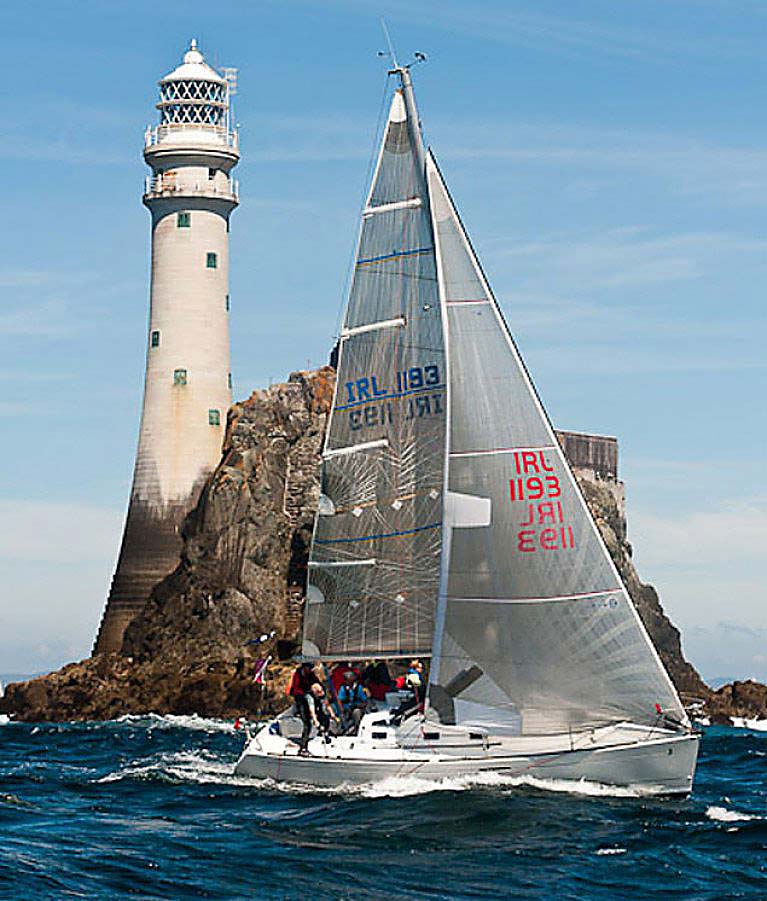 The Fastnet Rock is the only constant in the changing history of the Fastnet Race. Photo: Robert Bateman
The Fastnet Rock is the only constant in the changing history of the Fastnet Race. Photo: Robert Bateman
New Cowes-Fastnet-Cherbourg course
Although the Fastnet Races of 2021 and 2023 will use the new Cowes-Fastnet-Cherbourg course, it has been hinted that for historic 2025, this time-honoured course from Cowes to the Fastnet and thence to Plymouth will be resumed. But as it happens, it’s not the original course. The first Fastnet in 1925 started from the Royal Victoria YC at Ryde on the northeast coast of the Isle of Wight, and exited the Solent eastward, leaving the Isle of Wight to starboard before heading for the Fastnet Rock and then back to Plymouth. This was sailed annually from 1925 until 1931, after which the race became biennial. But the same course was retained except for 1935, when it started in the Western Solent and sent the fleet directly westwards from the Royal Solent YC at Yarmouth on the Isle of Wight.
The old course was resumed in 1937 and 1939, then after losing three races to World War II from 1939 to 1945, 1947’s race saw it resumed from the Eastern Solent. But with shoreside facilities problems in the immediate post-war period, that 1947 Royal Victoria YC start was provided from Portsmouth with assistance from the Royal Navy. Then in 1949, the start from the Royal Yacht Squadron at Cowes - with the fleet going westward - was introduced, and the Fastnet Race as virtually everyone today has known it was born.
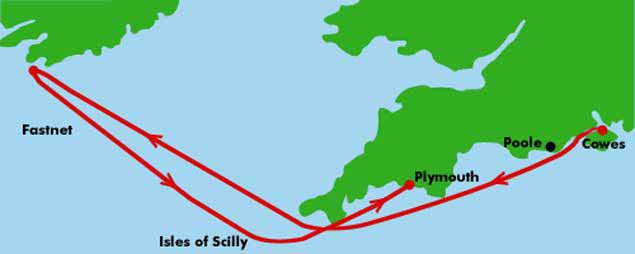 The “traditional” Fastnet Race course has only been sailed between 1949 and 2019, with three different start ports being used – with Ryde on the Isle of Wight the most frequent – before Cowes became the start point in 1949.
The “traditional” Fastnet Race course has only been sailed between 1949 and 2019, with three different start ports being used – with Ryde on the Isle of Wight the most frequent – before Cowes became the start point in 1949.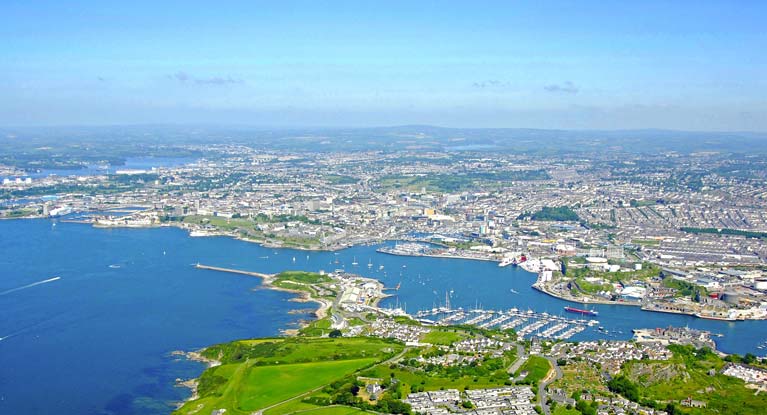 The port of Plymouth. While Cherbourg may have been indicated as the finish port for the Fastnet Races of 2021 and 2023, until now Plymouth has been the port most totally associated with the race. It wasn’t until 1949 – 24 years after it was first raced – that the Fastnet Race finally started from Cowes, but between 1925 and 2019, the race always finished in Plymouth.
The port of Plymouth. While Cherbourg may have been indicated as the finish port for the Fastnet Races of 2021 and 2023, until now Plymouth has been the port most totally associated with the race. It wasn’t until 1949 – 24 years after it was first raced – that the Fastnet Race finally started from Cowes, but between 1925 and 2019, the race always finished in Plymouth.
Overall Fastnet wins
Ireland’s successes in the Race over the years since its inception in 1925 have been distinctive, even if they aren’t numerous. But then, proportionately speaking, how many overall Fastnet wins should a country with our sailing population expect to achieve?
For there’s no doubt that enthusiastic national numbers with good boats and a strong success ethic throughout the crews will show in the results, as has been seen in recent years with the overall handicap winner table being dominated by the French. But then, just a couple of the more popular Breton sailing ports would have more boats between them than you’ll find in all Ireland, and the modern French offshore racing tradition, built on the well-earned hero-worship of Eric Tabarly and his successors, has solid foundations with achievements which are manifested in many ways.
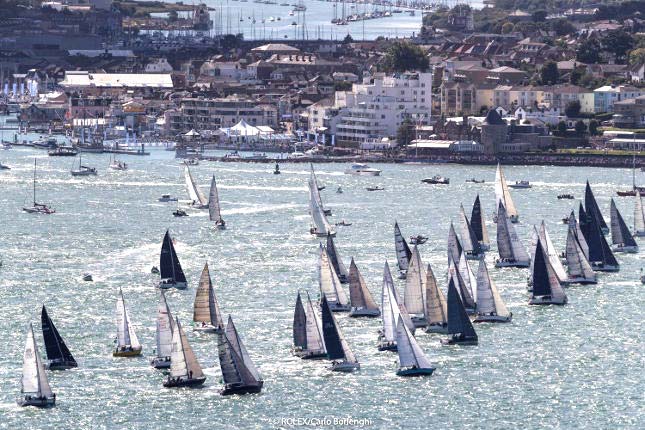 With a total fleet pushing towards the 400 mark, getting the contemporary Rolex Fastnet Race under way at Cowes is a continuous process of many class starts. Photo: Rolex/Carlo Borlenghi
With a total fleet pushing towards the 400 mark, getting the contemporary Rolex Fastnet Race under way at Cowes is a continuous process of many class starts. Photo: Rolex/Carlo Borlenghi
Harry Donegan’s Gull
Our own focus is inevitably narrower, but when we remember that one of the seven boats in the original Fastnet was Harry Donegan’s Gull out of Cork and that the Corkmen were leading the fleet going past Land’s End when outward bound for the Rock - even if they were third at the finish in Plymouth – suggests that Ireland may actually have punched above her weight, for the period of 1920 to 1960 was one of relatively low activity in Irish offshore racing.
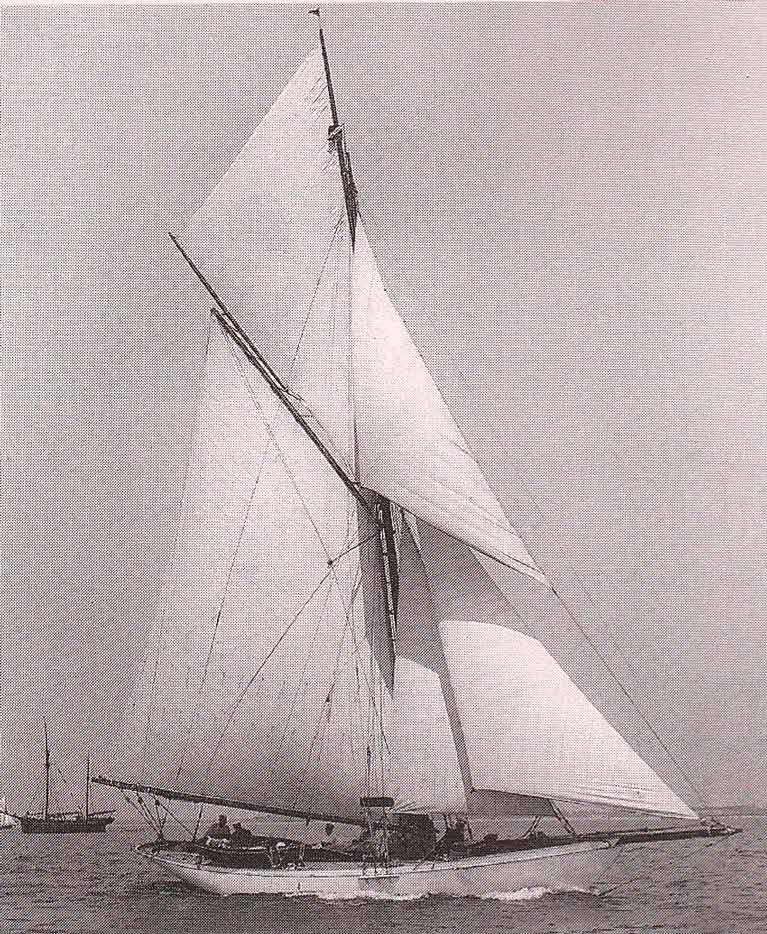 Harry Donegan’s Gull at the start of the first Fastnet Race from Ryde on the Isle of Wight in 1925. A17-ton gaff cutter designed by Charles E Nicholson and built by Camper & Nicholson in 1898, Gull was obliged under the rules of the new race to carry an adequate dinghy, which in this instance was kept upright on the starboard deck “as it was very handy for stowing gear”
Harry Donegan’s Gull at the start of the first Fastnet Race from Ryde on the Isle of Wight in 1925. A17-ton gaff cutter designed by Charles E Nicholson and built by Camper & Nicholson in 1898, Gull was obliged under the rules of the new race to carry an adequate dinghy, which in this instance was kept upright on the starboard deck “as it was very handy for stowing gear”
 Aboard Gull, driving hard during the first Fastnet Race in 1925. There were no rules requiring her to be fitted with guard rails, so she didn’t have them as they were considered “rather unsightly”.
Aboard Gull, driving hard during the first Fastnet Race in 1925. There were no rules requiring her to be fitted with guard rails, so she didn’t have them as they were considered “rather unsightly”.
That said, in 1947 Billy Mooney’s 42ft ketch Aideen out of Dun Laoghaire won her class in the 1947 Fastnet, as did Frank & Eric Hopkirk’s venerable cutter Glance from Belfast Lough in the race of 1953. But it has to be admitted that these wins were in numerically small divisions, and it wasn’t until the 1960s that Irish participation became more frequent.
By this stage, the Admiral's Cup was central to much of it, and it was a member of the 1971 team, Rory O’Hanlon’s S&S 43 Clarion from Dun Laoghaire Harbour, which went into the record books by winning the Philip Whitehead Cup, while the growth in the number of smaller boats was reflected in Ronnie Wayte taking second in the very large Class IV in that 1971 race in his new Hustler 35 Setanta of Skerries, which is currently – 49 years later - on the strength of the National YC in Dun Laoghaire.
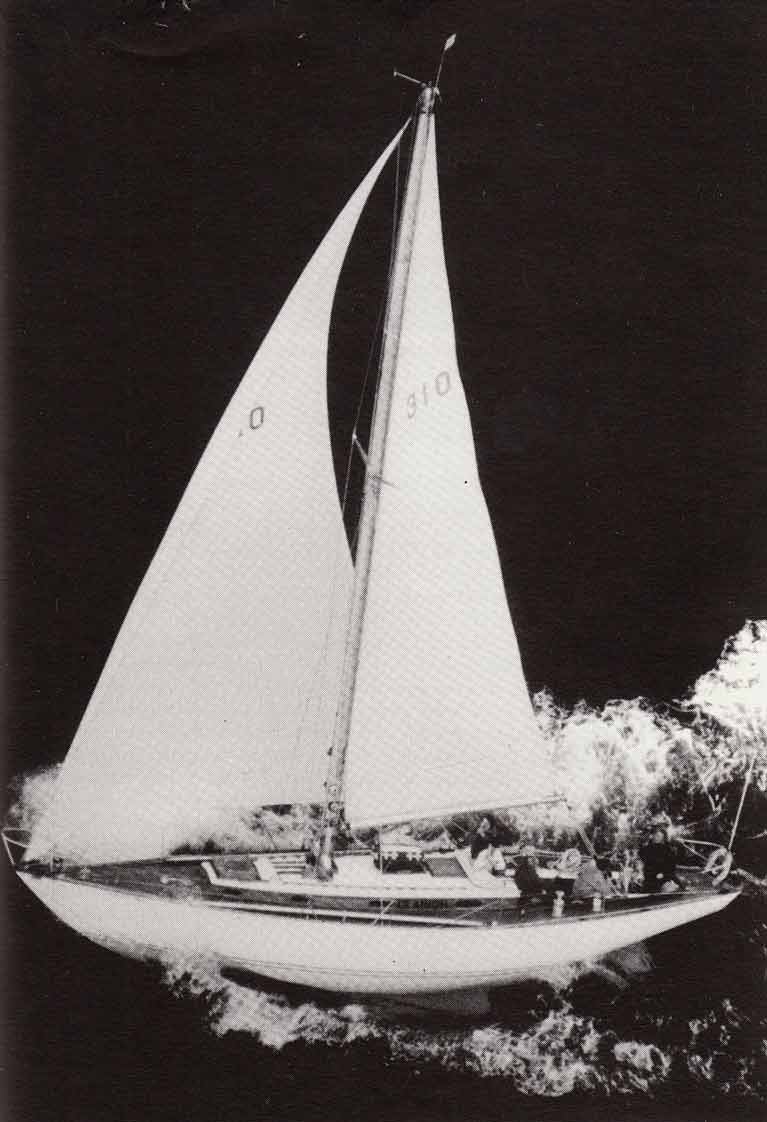 The classic 43ft Sparkman & Stephens Clarion (Dr Rory O’Hanlon RStGYC) during the 1971 Fastnet Race, in which she won the Philip Whitehead Cup
The classic 43ft Sparkman & Stephens Clarion (Dr Rory O’Hanlon RStGYC) during the 1971 Fastnet Race, in which she won the Philip Whitehead Cup
Fastnet Storm of 1979
Through the 1970s the pace built up, and in 1979 Ireland dominated the first stages of the Admiral's Cup, while in the first couple of hundred miles of the Fastnet Race itself, the betting was on as to whether Ken Rohan’s Holland 39 Regardless or Hugh Coveney’s Holland 43 Golden Apple would be the overall winner. But the Fastnet Storm of 1979 and the loss of both their rudders put paid to that high hope.
 Ken Rohan’s Holland 39 Regardless during the Irish Admirals Cup Trials at Cork, May 1981. With a crew built around Robert Dix, Drewry Pearson and Des Cummins, Regardless went on to be the top Admiral's Cup boat in the 1981 Fastnet Race. Photo: W M Nixon
Ken Rohan’s Holland 39 Regardless during the Irish Admirals Cup Trials at Cork, May 1981. With a crew built around Robert Dix, Drewry Pearson and Des Cummins, Regardless went on to be the top Admiral's Cup boat in the 1981 Fastnet Race. Photo: W M Nixon
Regardless
However, with a fresh crew including Young Turks like Robert Dix, Drewry Pearson and Des Cummins, Regardless was back for more in the 1981 Fastnet to achieve the best Irish result until then, the win in Class 1 and the overall win among all Admirals Cup boats.
They’re a talented trio, as Robert Dix – aka Dixie – had been the youngest ever All-Ireland Champion Helm at the age of 17 in October 1970 when the Helmsmans Championship – raced that year in National 18s – was the culmination of the Royal Cork’s Quarter Millennial celebrations. And ten years later, the trio were very much in action piloting Bruce Lyster’s eccentric Half Tonner Swuzzlebubble to overall victory in the 1980 ISORA Championship.
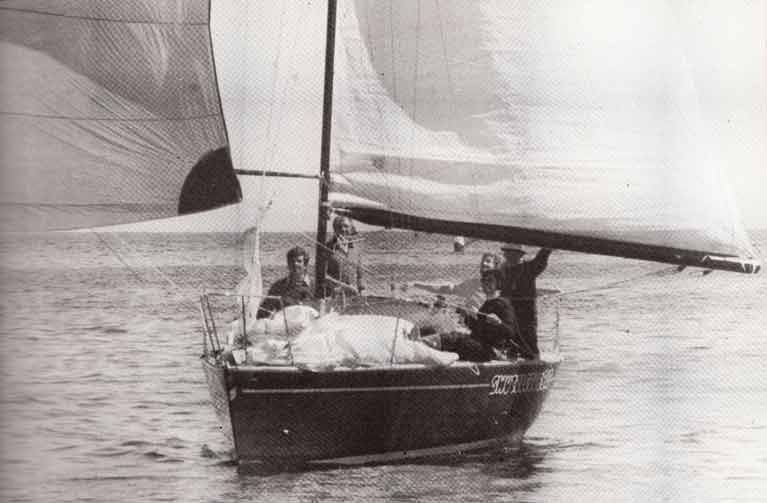 Bruce Lyster (left) on his originally-centreboard Half Tonner Swuzzlebubble coming in to win the Pwllheli-Howth Race of August 1980 - and the 1980 ISORA Championship with it - his crew including Robert Dix, Drewry Pearson and Des Cummins. Photo: W M Nixon
Bruce Lyster (left) on his originally-centreboard Half Tonner Swuzzlebubble coming in to win the Pwllheli-Howth Race of August 1980 - and the 1980 ISORA Championship with it - his crew including Robert Dix, Drewry Pearson and Des Cummins. Photo: W M Nixon
Admiral's Cup
Then came 1981, when the Admiral's Cup was arguably at its peak, so the Fastnet performance of Regardless was internationally acknowledged as something very special indeed. It certainly strengthened the already strong bond between the three guys, a bond which continues today in their joint ownership of the Hallberg Rassy 48 Alpaire of 2009 vintage, a particularly attractive Frers design in which they’ve recently been cruising the Black Sea.
But meanwhile, their performance with Regardless in 1981 had shown that clearly, the Big One was within sight, and in 1987 Ireland finally got the overall Fastnet Race win. Well, sort of…….
Thirty-three years ago, the growth of sponsorship in sailing could result in a confusion of results if rules from the era of total Corinthian participation were applied with precise regard for the last letter of the law. Thus although there were many sponsored entries racing in national teams in 1987’s highly competitive Admiral’s Cup for which the Fastnet Race was the climax, the peculiar reality was that none of them was eligible – because of being sponsored – to win the Fastnet Challenge Cup for the overall winner.
With a record fleet lining up for the Fastnet Race itself, and with thirteen teams competing with ferocious enthusiasm for the Admiral’s Cup in the best series for several years, it was so hectic in Cowes that the thought of an acute results problem arising in Plymouth after the Fastnet Race had finished does not seem to have been on the radar. Yet this is precisely what happened, and needless to say it was an Irish boat which was right at the eye of the storm.
Stephen Fein’s Dubois 40 Full Pelt was a late addition to the Irish Admiral’s Cup team. Skipper Tom Power of Dun Laoghaire had found that the boat he had originally chartered came with intractable rating problems. But in being forced into relatively last-minute negotiations with Full Pelt, the Irish fell on their feet.
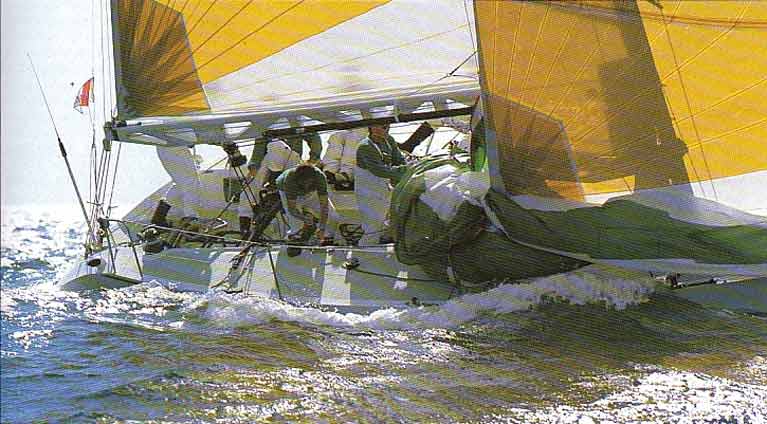 All systems go. The Dubois 40 Irish Independent racing in the 1987 Admirals Cup, Tim Goodbody is on the helm
All systems go. The Dubois 40 Irish Independent racing in the 1987 Admirals Cup, Tim Goodbody is on the helm
Full Pelt was the result of a dynamic linkup between owner Stephen Fein, his ace boat optimizer and tuner Jo Richards, and designer Ed Dubois. Yet despite being a boat which was clearly showing further potential with every outing, Full Pelt had yet to find a guaranteed team place as the Admiral's Cup moved up the agenda.
Negotiations took place with some urgency. With the support of non-sailing Team Captain Sean Flood, sponsorship was secured from the Irish Independent newspaper, and the delicate task of balancing a crew panel between Full Pelt’s core crew and Tom Power’s own talented squad – which included helmsman Tim Goodbody – was set in train. With generous give and take on both sides, a real team spirit emerged, and as the 1987 Admirals Cup got under way, it was clear that Irish Independent was very much a boat to be taken seriously, with Tim Goodbody proving to be the equal and sometimes the better of international helming superstars like Lawrie Smith.
 The crew of 1987 Fastnet Race winner Irish Independent at the Royal Irish YC on 2nd December 2016 were (left to right) Billy Pope, Tom Power, Jo Richards, Stephen Fein, Sean Flood (Team Captain), Tim Goodbody, Tom Roche and Graham Deegan. Photo: W M Nixon
The crew of 1987 Fastnet Race winner Irish Independent at the Royal Irish YC on 2nd December 2016 were (left to right) Billy Pope, Tom Power, Jo Richards, Stephen Fein, Sean Flood (Team Captain), Tim Goodbody, Tom Roche and Graham Deegan. Photo: W M Nixon
The Fastnet Race itself was a classic. In those days the big race started on the Saturday, and Irish Independent was very much in contention overall as she rounded the rock on the Monday evening. Then with the wind freshening wetly from the west, progress was rapid towards the finish at Plymouth, with the 40-footers finishing in a bunch around 0300hrs on the Wednesday morning.
This closeness of finish was exactly as Jo Richards had anticipated, and thus he had always been focused on keeping Irish Independent/Full Pelt’s rating a point or two below comparable boats. This meant that while the Richard Burrows-skippered Dubois 40 Jameson Whiskey rated 1.0195, Irish Independent clocked in at 1.0188. As often as not, Irish Independent would be ahead on the water anyway, but there was always this tiny ratings gap to fall back on, something which increased in significance with longer races and particularly with the Fastnet.
So on that wet pre-dawn Wednesday morning, Irish Independent was already well launched on her way to being declared overall winner of the Fastnet Race. And in a broadening of the scope of Irish success, it soon became clear that the legendary Holland 39 Imp, raced as a veteran by Roy Dickson of Howth, was also going to win the Philip Whitehead Cup. But in the euphoria of these achievements, it took a while before it was fully realised that despite the clarity of Irish Independent’s victory, there was no way she was going to win the coveted Fastnet Challenge Cup. That would go to the top-placed non-sponsored boat.
In the end, the band of brothers which had emerged from the melding of two crews aboard Irish Independent/Full Pelt had to be content with receiving a little silver dish – “a leprechaun’s hub-cap” as Tom Power described it – as the only acknowledgement of what they had done.
While everyone knew what the real situation was, the fact that the official records stated otherwise tended to obscure the facts with every passing year, and the untimely death early in 2016 of designer Ed Dubois – who had been an active crew member on the boat during the Fastnet Race – was a reminder that something needed to be done to put things in proper perspective.
Friday, December 2nd 2016 would normally have been a day on which people started seriously anticipating Christmas. But for those for whom Irish Independent/Full Pelt was a very special boat at the centre of an unusual but successful crew-merging project, Friday, December 2nd 2016 was the day on which the then Commodore of RORC, Michael Boyd, and the 1987 skipper of Irish Independent, the late Tom Power, jointly hosted a lunch in the Royal Irish Yacht Club in Dun Laoghaire to honour the memory of Ed Dubois and to celebrate the sportsmanship and goodwill of Stephen Fein and Jo Richards in throwing themselves so completely into campaigning with a crew of Irish strangers who had become close friends by the time the series was completed.
 Janet Grosvenor of the RORC and Graham Deegan, a crewmember on Irish Independent in 1987, in the RIYC December 2016. Photo: W M Nixon
Janet Grosvenor of the RORC and Graham Deegan, a crewmember on Irish Independent in 1987, in the RIYC December 2016. Photo: W M Nixon
An official stamp of approval was put on it all by the welcome presence of Janet Grosvenor, Assistant Secretary at the RORC in 1987, and key administrator of the Admiral's Cup, who has since been properly recognized for her great services over very many years to offshore racing by being conferred with Honorary Membership of the RORC. And thanks to links with Irish Lights, a new trophy – made from a prism from the light on the Fastnet Rock – was presented to Stephen Fein and Tom Power, acknowledging the boat’s clear overall win and complete with the names of the crew.
As for the full supporting cast at that lunch of 2016, it was extraordinary, as it included both the 1987 Team Captain Sean Flood, and the Team Manager Terry Johnson, it also included former RORC Commodore John Bourke who was navigator of Jameson Whiskey back in 1987, and it numbered almost the entire crew panel for Irish Independent/Full Pelt, including those who had sailed some of the races, and those who had stood aside to allow the core squad to race the boat round the Fastnet.
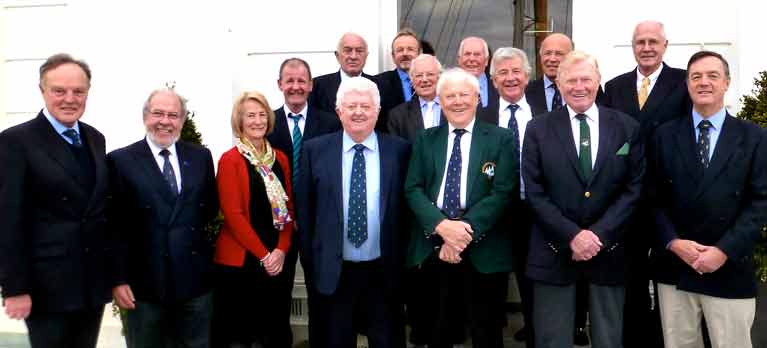 Putting the record straight. Among those who gathered at the RIYC in December 2016 to put the record straight on the real winner of the 1987 Fastnet Race were (left to right) Michael Boyd (Commodore RORC), Jim Horan (Commodore RIYC), Janet Grosvenor (RORC), Billy Pope (Irish Independent crew), Tom Power (Irish Independent skipper), Michael O’Leary (Fastnet contender), Jo Richards (Irish Independent designer/tactician), Stephen Fein (owner Full Pelt/Irish Independent), Terry Johnson (1987 Irish Admirals Cup Team Manager, Sean Flood (1987 Irish Admirals Cup Team Captain), Tom Roche (Skipper 1987 Irish Team Mumm 36), Tim Goodbody (Irish Independent helm), John Bourke (former Commodore RORC and navigator on 1987 Irish Team Dubois 40 Jameson), Graham Deegan (Irish Independent crew) and Paddy Boyd (Fastnet contender). Photo: W M Nixon
Putting the record straight. Among those who gathered at the RIYC in December 2016 to put the record straight on the real winner of the 1987 Fastnet Race were (left to right) Michael Boyd (Commodore RORC), Jim Horan (Commodore RIYC), Janet Grosvenor (RORC), Billy Pope (Irish Independent crew), Tom Power (Irish Independent skipper), Michael O’Leary (Fastnet contender), Jo Richards (Irish Independent designer/tactician), Stephen Fein (owner Full Pelt/Irish Independent), Terry Johnson (1987 Irish Admirals Cup Team Manager, Sean Flood (1987 Irish Admirals Cup Team Captain), Tom Roche (Skipper 1987 Irish Team Mumm 36), Tim Goodbody (Irish Independent helm), John Bourke (former Commodore RORC and navigator on 1987 Irish Team Dubois 40 Jameson), Graham Deegan (Irish Independent crew) and Paddy Boyd (Fastnet contender). Photo: W M Nixon
But although the question of just who really did win the 1987 Fastnet Race was finally resolved in a roundabout sort of way in Dun Laoghaire 29 years later, back in the late 1980s the amateur/professional/sponsorship thing was a conundrum which rumbled on for quite a while. Thus in Jamie Young’s article earlier this week about using eco-friendly auxiliary sail power for cargo and passenger-carrying commercial vessel, we mentioned in our intro that his West Coast-based Expedition Yacht, the Frers 49 Killlary Flyer, had been overall winner of the 1988 Round Ireland Race.
Well, this is true up to a point. But in 1988, Round Ireland Race Director Michael Jones of Wicklow was ultra-scrupulous in implementing the amateur/professional/sponsorship directives. And in those days, Killary Flyer was Brian Buchanan’s Hesperia from Belfast Lough. Yet she did the 1988 Round Ireland as Woodchester Challenger in a well-sponsored deal arranged by Liam Lawlor of Howth with support from the Dublin-based finance company, but skippered as usual by Dickie Gomes, who sailed with most of his regular crew.
Yet as far as Michael Jones was concerned, the sponsorship made the boat a completely different animal, and she could only race in the Channel Handicap Division, whereas all the main prizes were still being allocated in the International Offshore Rule division. It’s small consolation that the IOR was soon to be replaced with Channel Handicap’s offspring, the IRC, for in 1988 Dickie Gomes and his crew sailed the race of their lives round Ireland to be challenging Hesperia/Woodchester’s slightly bigger sister, Denis Doyle’s Moonduster, at every corner before coming home to a strong finish at Wicklow.
When the results became official, Woodchester may have won overall under CHS from Liam Shanahan’s db2S Lightning from the National YC. But in IOR among the proper silverware, Lightning was the winner by three hours from Tony Vernon’s 40-footer Canterbury from Abersoch with Moonduster third, while Woodchester Challenger was simply nowhere in every way, for as far as the IOR Division was concerned, she simply didn’t exist.
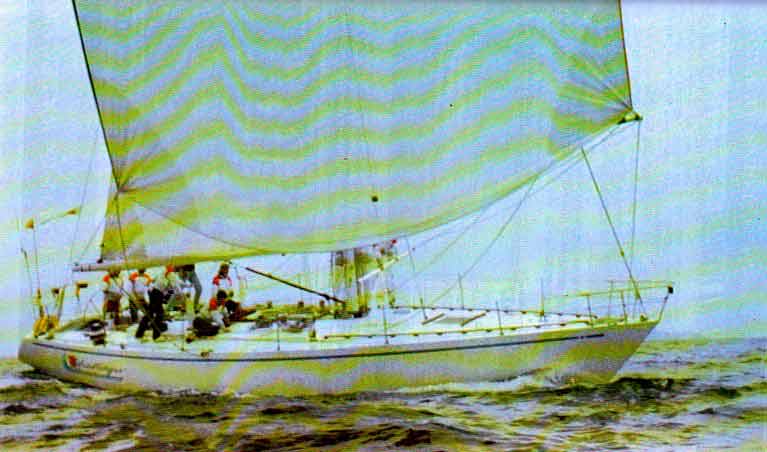 One of German Frers most attractive designs, this Frers 49 started life as Ron Amey’s Noryema XI. She then became Brian Buchanan’s Hesperia, while for the 1988 Round Ireland Race she was – as seen here – Woodchester Challenger, and these days she is Jamie Young’s Killary Flyer, the noted Arctic Expedition Yacht based in northwest Galway.
One of German Frers most attractive designs, this Frers 49 started life as Ron Amey’s Noryema XI. She then became Brian Buchanan’s Hesperia, while for the 1988 Round Ireland Race she was – as seen here – Woodchester Challenger, and these days she is Jamie Young’s Killary Flyer, the noted Arctic Expedition Yacht based in northwest Galway.
Yet in the special camaraderie which prevails at the end of a Round Ireland Race, the attitude seemed to be that we were getting two good winners for the price of one. Lightning’s win was deservedly popular, and remains so today, for the Shanahan family have now been making a massive contribution to Irish offshore racing for three generations. And Woodhester Challenger's race had been one of those flawless performances which falls rarely to anyone, and are cherished for their own sake.
But there’s a certain irony in the fact that for the next Round Ireland in 1990, a huge affair with a significant Maxi presence, all the old rules and reservations about commercial sponsorship of entries had been chucked out with total abandon. Absolutely everyone was in with a chance at all the main prizes, and the line honours winner and fully acknowledged overall winner was Lawrie Smith – with his crew including Gordon Maguire - racing the Maxi Rothmans, a sponsorship which would be seen these days as so toxic that the boat probably wouldn’t even be allowed into Irish territorial waters.
Meanwhile back at the Fastnet Race, with the absence of Moonduster after the deathn at the age of 81 of Denis Doyle in 2001, it fell to several boats to take on the mantle of Irish representation. And they did it very well, for although The Duster had been a regular entrant and in the Fastnet class frame at times, stellar results eluded her. But when another Crosshaven boat, Eric Lisson’s Noray 38 Cavatina - which was already well-known as a Round Ireland success - took on the Fastnet challenge in 2005, she came within 23 minutes of winning the Fastnet Challenge Cup.
Sailing in Class 3, they’d a race-long ding-dong with the slightly lower-rated Nicholson 33 Iromiguy (Jean-Yves Chateau). There was an unusually large amount of spinnaker work, and Eric Lisson recalls how as night drew on they’d see the all-too-familiar spinnaker of Iromiguy fading into the dark astern, then through the night they’d have that familiar impression of sailing so well that they were convinced they were dropping the Frenchmen. But as sure as God made little apples, as the dawn came up one of the sets of navigation lights astern would be revealed as having that damned Iromiguy spinnaker setting sweetly aloft.
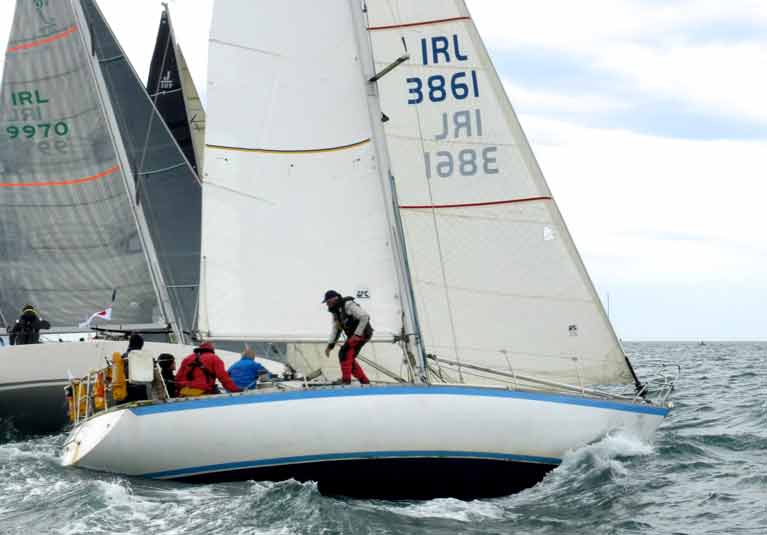 A boat and crew in harmony – Cavatina and her team came second overall (by 23 minutes) in the 2005 Fastnet Race, and won their Class in the race of 2007. Photo: W M Nixon
A boat and crew in harmony – Cavatina and her team came second overall (by 23 minutes) in the 2005 Fastnet Race, and won their Class in the race of 2007. Photo: W M Nixon
So at the finish Iromiguy had the class win by 23 minutes from Cavatina, and as the numbers overall fell the right way for boats of Class Three, Iromiguy had the Fastnet overall win too. It was the third Fastnet Challenge Cup win for Cork-based designer Ron Holland, as Iromiguy’s sister-ship Golden Delicious had won overall in 1975, while Dave Allen Holland 39 Imp won in 1977. Yet that was only small consolation for Cavatina’s all-amateur crew, to be so near and yet so far, even if the vast majority of offshore racers could not conceive of the wonder of coming second overall in a Fastnet Race.
Eric Lisson and longtime shipmate Dave Hennessy (who was subsequently to complete a four year global circumnavigation in his own boat Laragh) were to have considerable consolation in 2007 when they raced Cavatina in the AZAB and won overall against opposition including Jamie Young’s Frers 49 Killlary Flyer from Galway. Buoyed up by this success, Cavatina then went on to do the 2007 Fastnet Race in which, this time round, they got the class win. But overall it wasn’t Class 3’s race, yet with Cavatina’s class win and another noted success, 2007 was arguably Ireland’s best Fastnet Race to date.
For it was the race of 2007 – all of twenty years after Irish Independent’s win – which secured the overall win again, and this time the Fastnet Challenge Cup came with it with no equivocation.
For this was the year of Ger O’Rourke’s Cookson 50 Chieftain from the Royal Western Yacht Club of Ireland in Kilrush. The Limerick skipper had his own way of doing things, such there were factors around Chieftain’s win which made it an epochal achievement in the purest if sometimes a rather crazy spirit of Irish offshore racing.
For a start, Ger O’Rourke – who’d already taken a class win and fourth overall in the Sydney-Hobart Race when his boat was still fresh from the builders in New Zealand – had a superstition about not officially entering Chieftain for the next big race on her outline programme until she had completed the one in which she was currently involved. In 2007, she raced the New York to Hamburg Race, taking second. But it was only once she was in Hamburg in late June that Ger got in touch with the RORC about the Fastnet, to be told that they’d take his entry, but he’d be 46th on the waiting list as the 2007 Fastnet Race had long since been over-subscribed.
It sounds daft, but there hadn’t been a real gale in open water in the Fastnet Race since the mega-storm of the 1979 disaster, and people were still nervous of its memory. Thus the RORC office were confident that there’d be a lot of drop-outs as the 2007 race approached, as it was a very unsettled summer. They were right, with Chieftain moving up the waiting list so rapidly that Ger considered it worth his while to position his boat in the Solent, where by the Tuesday before the race on Sunday, he was told he was now highly likely, and his full entry was confirmed on the Thursday.
As it happened, he’d four days to the start, for though it had been planned for the Sunday, a short sharp severe storm zapping up the English Channel saw it being postponed 25 hours until the Monday, which didn’t help the jitteriness of many crews. But Chieftain’s team were made of sterner stuff, and on Monday there she was, confidently thumping her way to windward down the Solent in the midst of the Fastnet fleet with her canting keel earnings its keep and with a crew who, if they lacked anything resembling a crew uniform, seemed to be on top of their game with the prodigious talent of Jochem Visser included in the strength.
 Chieftain making knots to windward down the Solent in the 2007 Fastnet Race – she had been an official entry for barely three days
Chieftain making knots to windward down the Solent in the 2007 Fastnet Race – she had been an official entry for barely three days
As the bulk of the fleet approached the Lizard still slugging to windward, a serious gale warning led to multiple retirals – more than a hundred, for the memory of 1979 was still very strong. But the canting keel Chieftain was just getting into her stride despite all her electronics crashing before she cleared Lizard Point. Thereafter, all navigation and strategy and tactics were reliant on little hand-held GPS sets and a set of very sodden paper charts, but it didn’t take a feather out of them even if their boat’s size and speed made them one of a kind, racing largely on their own with nobody to compare their performance with, and little-noticed in the on-going race reports.
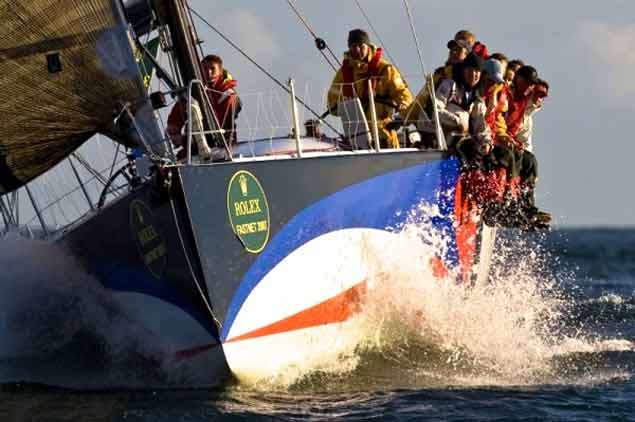 The winner that came out of nowhere…..Chieftain approaching the finish of the Rolex Fastnet Race 2007 on the Tuesday evening
The winner that came out of nowhere…..Chieftain approaching the finish of the Rolex Fastnet Race 2007 on the Tuesday evening
Thus it was something of a surprise when Chieftain appeared on her own out of the late evening light as Thursday night drew on, and finished towards sunset into an unchallengeable winning position. Conditions had ideally suited a boat of her size and type, but there were several comparable craft – it was Chieftain the last-minute entry which had read it to perfection for a very clearcut Irish win, and now Ger O’Rourke had an unexpected problem – he had to hit the shops in Plymouth to find a clean shirt for the prize-giving.
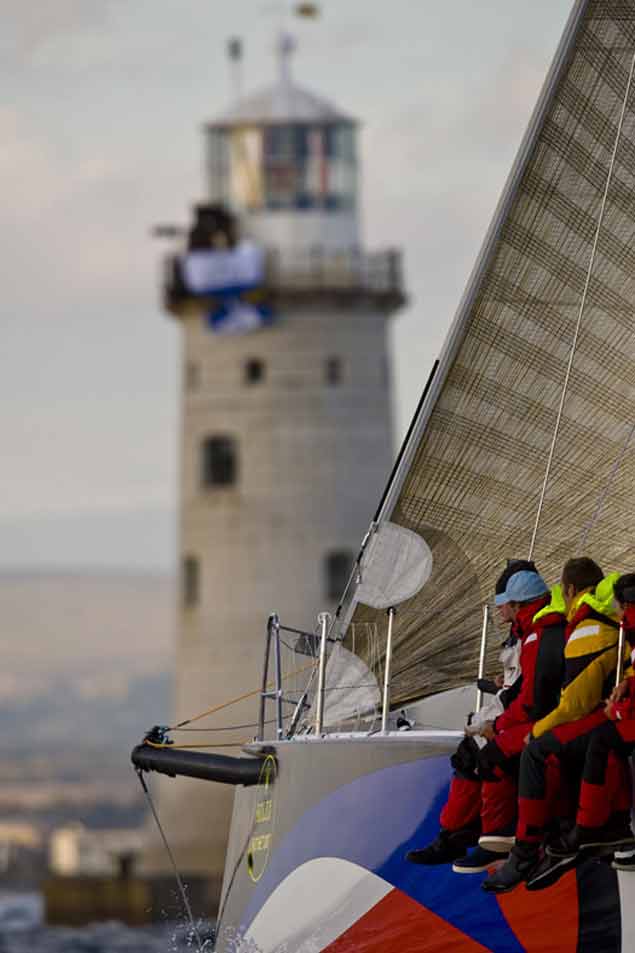 Home before dark – Chieftain and her motley crew cross the finish line at Plymouth to win the Rolex Fastnet Race 2007. Owner/skipper Ger O’Rourke had some unexpected retail therapy in having to buy a clean shirt for the prize-giving
Home before dark – Chieftain and her motley crew cross the finish line at Plymouth to win the Rolex Fastnet Race 2007. Owner/skipper Ger O’Rourke had some unexpected retail therapy in having to buy a clean shirt for the prize-giving
It had been a magnificent win, and in its total individuality, it stands alone. Since then, Irish success in the Fastnet has been for the Roger Justice Trophy for Sailing Schools, with Ronan O Siochru with Irish offshore sailing’s Sunfast 37 Desert Star winning in 2015, while Kenneth Rumball with Irish National Sailing School’s J/109 Jedi won it in 2017.
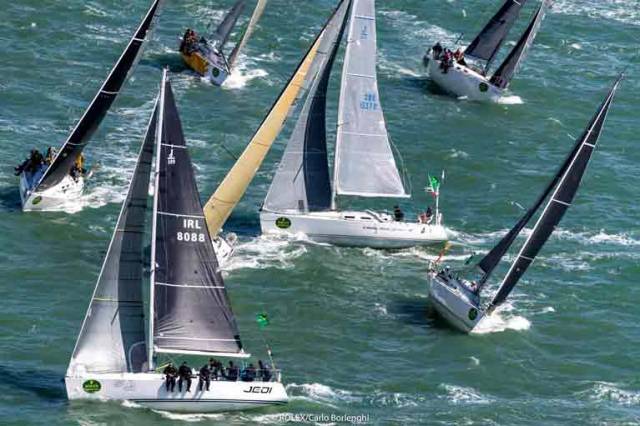 The Irish National Sailing School’s J/109 Jedi (left foreground) makes a neat start to the Rolex Fastnet Race 2017 in which she won the Roger Justice Trophy. Photo Rolex/Carlo Borlenghi
The Irish National Sailing School’s J/109 Jedi (left foreground) makes a neat start to the Rolex Fastnet Race 2017 in which she won the Roger Justice Trophy. Photo Rolex/Carlo Borlenghi
So all in all, it’s a more-than-reasonable record of Fastnet success for Ireland. And anyway, it is our rock, after all, is said and done. So we undoubtedly have skin in the game for 2025’s Centenary, and doubtless, there are several top sailors thinking about it already, though the way the enormous but still limited online entry list is filled within minutes of opening for business makes it a bit of a lottery securing a place.
That said, straightforward priority should be given to boat with a gold standard Fastnet Race history, and it’s particularly notable how many pre-World War II Fastnet Race overall winners are still happily with us, including Bloodhound from 1939, Stormy Weather from 1935, Dorade from 1933 and 1931, and Tally Ho from 1927 which is currently (as reported in Afloat) being restored.
 Still going strong. The beautifully-restored 1931 and 1933 Fastnet Race winner Dorade (left) chasing the 1935 winner Stormy Weather in the race of 2015 – despite being five years older, Dorade finished ahead. Photo: Rolex/Daniel Forster
Still going strong. The beautifully-restored 1931 and 1933 Fastnet Race winner Dorade (left) chasing the 1935 winner Stormy Weather in the race of 2015 – despite being five years older, Dorade finished ahead. Photo: Rolex/Daniel Forster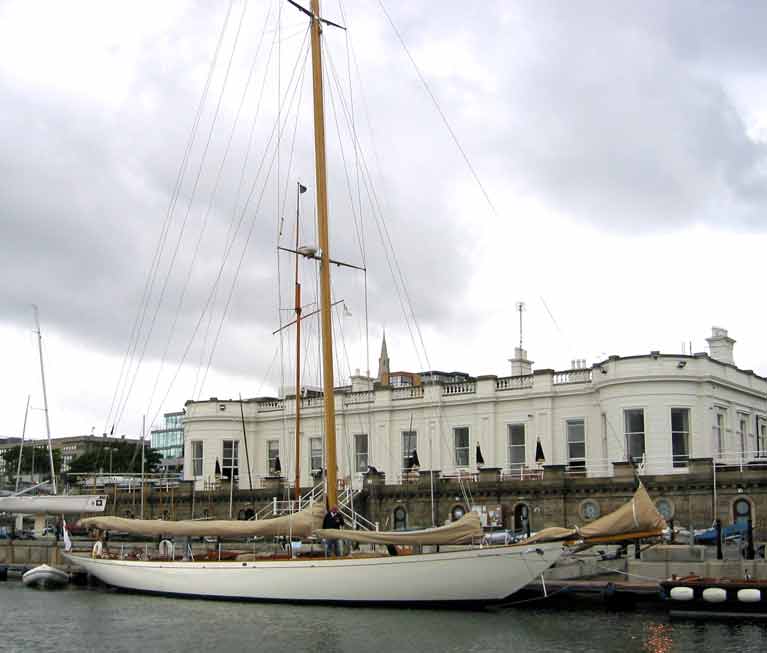 The 70ft Hallowe’en at the Royal Irish YC in Dun Laoghaire. Designed and built by Fife of Fairlie, Hallowe’en won line honours in the 1926 Fastnet Race in her first season afloat. Photo: W M Nixon
The 70ft Hallowe’en at the Royal Irish YC in Dun Laoghaire. Designed and built by Fife of Fairlie, Hallowe’en won line honours in the 1926 Fastnet Race in her first season afloat. Photo: W M Nixon
Also making their stately way afloat are the 1939 line honours winner, the 88ft Nordwind, and the 1926 line honours champion, the Irish-owned 70ft Fife-designed-and-built beauty Hallowe’en. But important as these Fastnet veterans are, for sheer prominence in the race’s history, none can rival the former Pilot Cutter Jolie Brise, winner for George Martin in the first race of 1925 and for Bobby Somerset in 1929 and 1930.
Jolie Brise is reckoned by the pundits to be the finest pilot cutter ever built. And her three successes in the early Fastnets were pointers to the success pattern in the modern race. For Jolie Brise is French-designed, and French-built. She was the last sailing pilot cutter to be commissioned for the vital service out of Le Havre in Normandy. She sails like a witch. Jolie Brise is very special indeed.
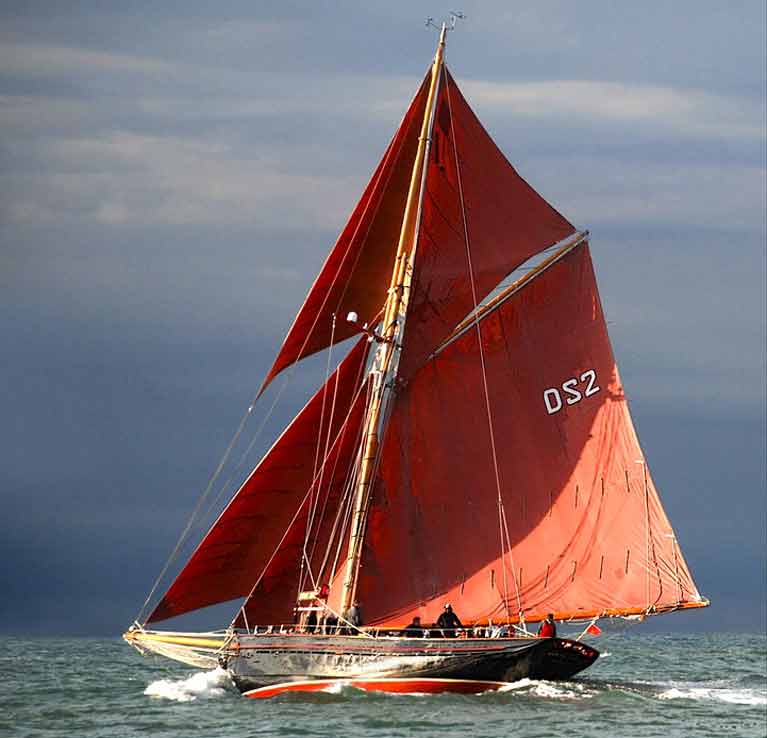 The last (and greatest) of Le Havre’s sailing pilot cutters, Jolie Brise was designed and built in France in 1913, and has won three Fastnet Races including the first one in 1925, plus the races of 1929 and 1930. She is now beautifully maintained and well used by Dauntsey’s School of Wiltshire in England
The last (and greatest) of Le Havre’s sailing pilot cutters, Jolie Brise was designed and built in France in 1913, and has won three Fastnet Races including the first one in 1925, plus the races of 1929 and 1930. She is now beautifully maintained and well used by Dauntsey’s School of Wiltshire in England
Irish Success in the Fastnet Race
- 1925 Gull (HPF Donegan, Royal Cork YC) 3rd overall
- 1926 Hallowe’en (now owned by Royal Irish YC syndicate) First to finish
- 1947 Aideen (A.W. Mooney, Irish Cruising Club) First in Class A
- 1947 Marama (Harald Osterberg, ICC) Second Class A
- 1953 Glance (F & E Hopkirk, Royal Ulster YC) 1st Div A, Jolie Brise Cup
- 1971 Clarion of Wight (Dr Rory O’Hanlon, Irish CC & Royal St George YC) First Division A and Philip Whitehead Cup
- 1971 Setanta of Skerries (Ronnie Wayte, Irish Cr C & Skerries SC) Second Class IV
- 1981 Regardless (Ken Rohan, Royal Irish YC) First Class 1
- 1987 Irish independent/Full Pelt (Tom Power & Stephen Fein, Royal Irish YC) First overall
- 1987 Imp (Roy Dickson, Howth YC) 1st Div A, Philip Whitehead Cup
- 2005 Cavatina (Eric Lisson, Royal Cork YC) 2nd Overall and 2nd Class 3
- 2007 Chieftain (Ger O’Rourke, Royal Western of Ireland YC) First overall and Fastnet Challenge Cup, RORC Yacht of the Year 2007)
- 2007 Cavatina (Eric Lisson, RCYC) First Class 3
- 2015 Desert Star (Ronan O Siochru, Irish Offshore Sailing) Roger Justice Trophy
- 2017 Jedi (Kenneth Rumball, Irish National SS) Roger Justice Trophy
*Afloat.ie welcomes any additions and corrections to the above



























